Python著名游戏实战之方块连接 我的世界
目录
- 导语
- 正文
- (1)《我是世界》游戏规则。
- (2)主要程序代码。
- (3)效果图如下。
- 总结
导语
《我的世界》是一款自由度极高的游戏,每个新存档的开启,就像是作为造物主的玩家在虚拟空间开辟了一个全新的宇宙。
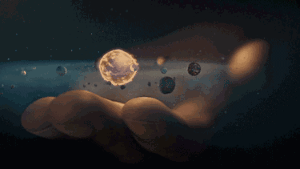
方块连接世界,云游大好河山。

国庆不是回家了一趟嘛?隔壁家的小胖墩在跟家里的小孩子一起玩手机,一起下载 了这款《我的世界》的游戏,玩儿的可是非常起劲儿了,建房子打怪,别说那房子的模型着实蛮惊艳的哈!
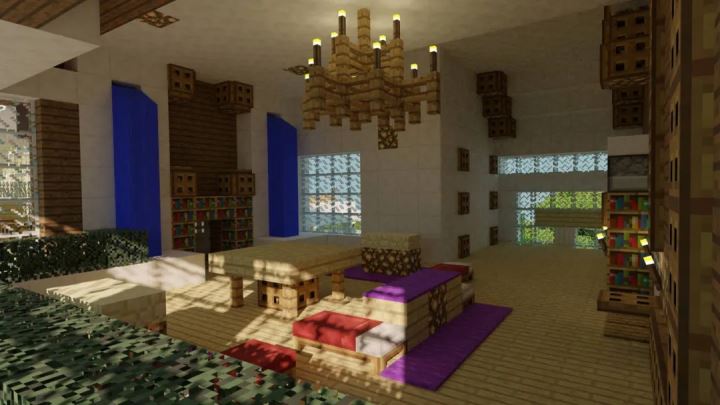
至少我作为一个没玩过的人来说确实是很牛逼了~
至少我做不来哈哈哈!这游戏看着怪好玩儿的撒,小编没忍住,毕竟长假嘛,怎得找点儿事情可做!
于是——今天木木子带大家一起编写的Python 1.0初级版本《我的世界》就要隆重出场了,期不期待吖~
正文

(1)《我是世界》游戏规则。
移动—前进:W,后退:S,向左:A,向右:D,环顾四周:鼠标,跳起:空格键,切换飞行模式:Tab。
选择建筑材料—砖:1,草:2,沙子:3,删除建筑:鼠标左键单击,创建建筑块:鼠标右键单击。
ESC退出程序。
(2)主要程序代码。
'''
主题:
我的世界1.0版本
'''
from __future__ import division
import sys
import math
import random
import time
from collections import deque
from pyglet import image
from pyglet.gl import *
from pyglet.graphics import TextureGroup
from pyglet.window import key, mouse
TICKS_PER_SEC = 60
# Size of sectors used to ease block loading.
SECTOR_SIZE = 16
WALKING_SPEED = 5
FLYING_SPEED = 15
GRAVITY = 20.0
MAX_JUMP_HEIGHT = 1.0 # About the height of a block.
# To derive the formula for calculating jump speed, first solve
# v_t = v_0 + a * t
# for the time at which you achieve maximum height, where a is the acceleration
# due to gravity and v_t = 0. This gives:
# t = - v_0 / a
# Use t and the desired MAX_JUMP_HEIGHT to solve for v_0 (jump speed) in
# s = s_0 + v_0 * t + (a * t^2) / 2
JUMP_SPEED = math.sqrt(2 * GRAVITY * MAX_JUMP_HEIGHT)
TERMINAL_VELOCITY = 50
PLAYER_HEIGHT = 2
if sys.version_info[0] >= 3:
xrange = range
def cube_vertices(x, y, z, n):
""" Return the vertices of the cube at position x, y, z with size 2*n.
"""
return [
x-n,y+n,z-n, x-n,y+n,z+n, x+n,y+n,z+n, x+n,y+n,z-n, # top
x-n,y-n,z-n, x+n,y-n,z-n, x+n,y-n,z+n, x-n,y-n,z+n, # bottom
x-n,y-n,z-n, x-n,y-n,z+n, x-n,y+n,z+n, x-n,y+n,z-n, # left
x+n,y-n,z+n, x+n,y-n,z-n, x+n,y+n,z-n, x+n,y+n,z+n, # right
x-n,y-n,z+n, x+n,y-n,z+n, x+n,y+n,z+n, x-n,y+n,z+n, # front
x+n,y-n,z-n, x-n,y-n,z-n, x-n,y+n,z-n, x+n,y+n,z-n, # back
]
def tex_coord(x, y, n=4):
""" Return the bounding vertices of the texture square.
"""
m = 1.0 / n
dx = x * m
dy = y * m
return dx, dy, dx + m, dy, dx + m, dy + m, dx, dy + m
def tex_coords(top, bottom, side):
""" Return a list of the texture squares for the top, bottom and side.
"""
top = tex_coord(*top)
bottom = tex_coord(*bottom)
side = tex_coord(*side)
result = []
result.extend(top)
result.extend(bottom)
result.extend(side * 4)
return result
TEXTURE_PATH = 'texture.png'
GRASS = tex_coords((1, 0), (0, 1), (0, 0))
SAND = tex_coords((1, 1), (1, 1), (1, 1))
BRICK = tex_coords((2, 0), (2, 0), (2, 0))
STONE = tex_coords((2, 1), (2, 1), (2, 1))
FACES = [
( 0, 1, 0),
( 0,-1, 0),
(-1, 0, 0),
( 1, 0, 0),
( 0, 0, 1),
( 0, 0,-1),
]
def normalize(position):
""" Accepts `position` of arbitrary precision and returns the block
containing that position.
Parameters
----------
position : tuple of len 3
Returns
-------
block_position : tuple of ints of len 3
"""
x, y, z = position
x, y, z = (int(round(x)), int(round(y)), int(round(z)))
return (x, y, z)
def sectorize(position):
""" Returns a tuple representing the sector for the given `position`.
Parameters
----------
position : tuple of len 3
Returns
-------
sector : tuple of len 3
"""
x, y, z = normalize(position)
x, y, z = x // SECTOR_SIZE, y // SECTOR_SIZE, z // SECTOR_SIZE
return (x, 0, z)
class Model(object):
def __init__(self):
# A Batch is a collection of vertex lists for batched rendering.
self.batch = pyglet.graphics.Batch()
# A TextureGroup manages an OpenGL texture.
self.group = TextureGroup(image.load(TEXTURE_PATH).get_texture())
# A mapping from position to the texture of the block at that position.
# This defines all the blocks that are currently in the world.
self.world = {}
# Same mapping as `world` but only contains blocks that are shown.
self.shown = {}
# Mapping from position to a pyglet `VertextList` for all shown blocks.
self._shown = {}
# Mapping from sector to a list of positions inside that sector.
self.sectors = {}
# Simple function queue implementation. The queue is populated with
# _show_block() and _hide_block() calls
self.queue = deque()
self._initialize()
def _initialize(self):
""" Initialize the world by placing all the blocks.
"""
n = 80 # 1/2 width and height of world
s = 1 # step size
y = 0 # initial y height
for x in xrange(-n, n + 1, s):
for z in xrange(-n, n + 1, s):
# create a layer stone an grass everywhere.
self.add_block((x, y - 2, z), GRASS, immediate=False)
self.add_block((x, y - 3, z), STONE, immediate=False)
if x in (-n, n) or z in (-n, n):
# create outer walls.
for dy in xrange(-2, 3):
self.add_block((x, y + dy, z), STONE, immediate=False)
# generate the hills randomly
o = n - 10
for _ in xrange(120):
a = random.randint(-o, o) # x position of the hill
b = random.randint(-o, o) # z position of the hill
c = -1 # base of the hill
h = random.randint(1, 6) # height of the hill
s = random.randint(4, 8) # 2 * s is the side length of the hill
d = 1 # how quickly to taper off the hills
t = random.choice([GRASS, SAND, BRICK])
for y in xrange(c, c + h):
for x in xrange(a - s, a + s + 1):
for z in xrange(b - s, b + s + 1):
if (x - a) ** 2 + (z - b) ** 2 > (s + 1) ** 2:
continue
if (x - 0) ** 2 + (z - 0) ** 2 < 5 ** 2:
continue
self.add_block((x, y, z), t, immediate=False)
s -= d # decrement side lenth so hills taper off
def hit_test(self, position, vector, max_distance=8):
""" Line of sight search from current position. If a block is
intersected it is returned, along with the block previously in the line
of sight. If no block is found, return None, None.
Parameters
----------
position : tuple of len 3
The (x, y, z) position to check visibility from.
vector : tuple of len 3
The line of sight vector.
max_distance : int
How many blocks away to search for a hit.
"""
m = 8
x, y, z = position
dx, dy, dz = vector
previous = None
for _ in xrange(max_distance * m):
key = normalize((x, y, z))
if key != previous and key in self.world:
return key, previous
previous = key
x, y, z = x + dx / m, y + dy / m, z + dz / m
return None, None
def exposed(self, position):
""" Returns False is given `position` is surrounded on all 6 sides by
blocks, True otherwise.
"""
x, y, z = position
for dx, dy, dz in FACES:
if (x + dx, y + dy, z + dz) not in self.world:
return True
return False
def add_block(self, position, texture, immediate=True):
""" Add a block with the given `texture` and `position` to the world.
Parameters
----------
position : tuple of len 3
The (x, y, z) position of the block to add.
texture : list of len 3
The coordinates of the texture squares. Use `tex_coords()` to
generate.
immediate : bool
Whether or not to draw the block immediately.
"""
if position in self.world:
self.remove_block(position, immediate)
self.world[position] = texture
self.sectors.setdefault(sectorize(position), []).append(position)
if immediate:
if self.exposed(position):
self.show_block(position)
self.check_neighbors(position)
def remove_block(self, position, immediate=True):
""" Remove the block at the given `position`.
Parameters
----------
position : tuple of len 3
The (x, y, z) position of the block to remove.
immediate : bool
Whether or not to immediately remove block from canvas.
"""
del self.world[position]
self.sectors[sectorize(position)].remove(position)
if immediate:
if position in self.shown:
self.hide_block(position)
self.check_neighbors(position)
def check_neighbors(self, position):
""" Check all blocks surrounding `position` and ensure their visual
state is current. This means hiding blocks that are not exposed and
ensuring that all exposed blocks are shown. Usually used after a block
is added or removed.
"""
x, y, z = position
for dx, dy, dz in FACES:
key = (x + dx, y + dy, z + dz)
if key not in self.world:
continue
if self.exposed(key):
if key not in self.shown:
self.show_block(key)
else:
if key in self.shown:
self.hide_block(key)
def show_block(self, position, immediate=True):
""" Show the block at the given `position`. This method assumes the
block has already been added with add_block()
Parameters
----------
position : tuple of len 3
The (x, y, z) position of the block to show.
immediate : bool
Whether or not to show the block immediately.
"""
texture = self.world[position]
self.shown[position] = texture
if immediate:
self._show_block(position, texture)
else:
self._enqueue(self._show_block, position, texture)
def _show_block(self, position, texture):
""" Private implementation of the `show_block()` method.
Parameters
----------
position : tuple of len 3
The (x, y, z) position of the block to show.
texture : list of len 3
The coordinates of the texture squares. Use `tex_coords()` to
generate.
"""
x, y, z = position
vertex_data = cube_vertices(x, y, z, 0.5)
texture_data = list(texture)
# create vertex list
# FIXME Maybe `add_indexed()` should be used instead
self._shown[position] = self.batch.add(24, GL_QUADS, self.group,
('v3f/static', vertex_data),
('t2f/static', texture_data))
def hide_block(self, position, immediate=True):
""" Hide the block at the given `position`. Hiding does not remove the
block from the world.
Parameters
----------
position : tuple of len 3
The (x, y, z) position of the block to hide.
immediate : bool
Whether or not to immediately remove the block from the canvas.
"""
self.shown.pop(position)
if immediate:
self._hide_block(position)
else:
self._enqueue(self._hide_block, position)
def _hide_block(self, position):
""" Private implementation of the 'hide_block()` method.
"""
self._shown.pop(position).delete()
def show_sector(self, sector):
""" Ensure all blocks in the given sector that should be shown are
drawn to the canvas.
"""
for position in self.sectors.get(sector, []):
if position not in self.shown and self.exposed(position):
self.show_block(position, False)
def hide_sector(self, sector):
""" Ensure all blocks in the given sector that should be hidden are
removed from the canvas.
"""
for position in self.sectors.get(sector, []):
if position in self.shown:
self.hide_block(position, False)
def change_sectors(self, before, after):
""" Move from sector `before` to sector `after`. A sector is a
contiguous x, y sub-region of world. Sectors are used to speed up
world rendering.
"""
before_set = set()
after_set = set()
pad = 4
for dx in xrange(-pad, pad + 1):
for dy in [0]: # xrange(-pad, pad + 1):
for dz in xrange(-pad, pad + 1):
if dx ** 2 + dy ** 2 + dz ** 2 > (pad + 1) ** 2:
continue
if before:
x, y, z = before
before_set.add((x + dx, y + dy, z + dz))
if after:
x, y, z = after
after_set.add((x + dx, y + dy, z + dz))
show = after_set - before_set
hide = before_set - after_set
for sector in show:
self.show_sector(sector)
for sector in hide:
self.hide_sector(sector)
def _enqueue(self, func, *args):
""" Add `func` to the internal queue.
"""
self.queue.append((func, args))
def _dequeue(self):
""" Pop the top function from the internal queue and call it.
"""
func, args = self.queue.popleft()
func(*args)
def process_queue(self):
""" Process the entire queue while taking periodic breaks. This allows
the game loop to run smoothly. The queue contains calls to
_show_block() and _hide_block() so this method should be called if
add_block() or remove_block() was called with immediate=False
"""
start = time.clock()
while self.queue and time.clock() - start < 1.0 / TICKS_PER_SEC:
self._dequeue()
def process_entire_queue(self):
""" Process the entire queue with no breaks.
"""
while self.queue:
self._dequeue()
class Window(pyglet.window.Window):
def __init__(self, *args, **kwargs):
super(Window, self).__init__(*args, **kwargs)
# Whether or not the window exclusively captures the mouse.
self.exclusive = False
# When flying gravity has no effect and speed is increased.
self.flying = False
# Strafing is moving lateral to the direction you are facing,
# e.g. moving to the left or right while continuing to face forward.
#
# First element is -1 when moving forward, 1 when moving back, and 0
# otherwise. The second element is -1 when moving left, 1 when moving
# right, and 0 otherwise.
self.strafe = [0, 0]
# Current (x, y, z) position in the world, specified with floats. Note
# that, perhaps unlike in math class, the y-axis is the vertical axis.
self.position = (0, 0, 0)
# First element is rotation of the player in the x-z plane (ground
# plane) measured from the z-axis down. The second is the rotation
# angle from the ground plane up. Rotation is in degrees.
#
# The vertical plane rotation ranges from -90 (looking straight down) to
# 90 (looking straight up). The horizontal rotation range is unbounded.
self.rotation = (0, 0)
# Which sector the player is currently in.
self.sector = None
# The crosshairs at the center of the screen.
self.reticle = None
# Velocity in the y (upward) direction.
self.dy = 0
# A list of blocks the player can place. Hit num keys to cycle.
self.inventory = [BRICK, GRASS, SAND]
# The current block the user can place. Hit num keys to cycle.
self.block = self.inventory[0]
# Convenience list of num keys.
self.num_keys = [
key._1, key._2, key._3, key._4, key._5,
key._6, key._7, key._8, key._9, key._0]
# Instance of the model that handles the world.
self.model = Model()
# The label that is displayed in the top left of the canvas.
self.label = pyglet.text.Label('', font_name='Arial', font_size=18,
x=10, y=self.height - 10, anchor_x='left', anchor_y='top',
color=(0, 0, 0, 255))
# This call schedules the `update()` method to be called
# TICKS_PER_SEC. This is the main game event loop.
pyglet.clock.schedule_interval(self.update, 1.0 / TICKS_PER_SEC)
def set_exclusive_mouse(self, exclusive):
""" If `exclusive` is True, the game will capture the mouse, if False
the game will ignore the mouse.
"""
super(Window, self).set_exclusive_mouse(exclusive)
self.exclusive = exclusive
def get_sight_vector(self):
""" Returns the current line of sight vector indicating the direction
the player is looking.
"""
x, y = self.rotation
# y ranges from -90 to 90, or -pi/2 to pi/2, so m ranges from 0 to 1 and
# is 1 when looking ahead parallel to the ground and 0 when looking
# straight up or down.
m = math.cos(math.radians(y))
# dy ranges from -1 to 1 and is -1 when looking straight down and 1 when
# looking straight up.
dy = math.sin(math.radians(y))
dx = math.cos(math.radians(x - 90)) * m
dz = math.sin(math.radians(x - 90)) * m
return (dx, dy, dz)
def get_motion_vector(self):
""" Returns the current motion vector indicating the velocity of the
player.
Returns
-------
vector : tuple of len 3
Tuple containing the velocity in x, y, and z respectively.
"""
if any(self.strafe):
x, y = self.rotation
strafe = math.degrees(math.atan2(*self.strafe))
y_angle = math.radians(y)
x_angle = math.radians(x + strafe)
if self.flying:
m = math.cos(y_angle)
dy = math.sin(y_angle)
if self.strafe[1]:
# Moving left or right.
dy = 0.0
m = 1
if self.strafe[0] > 0:
# Moving backwards.
dy *= -1
# When you are flying up or down, you have less left and right
# motion.
dx = math.cos(x_angle) * m
dz = math.sin(x_angle) * m
else:
dy = 0.0
dx = math.cos(x_angle)
dz = math.sin(x_angle)
else:
dy = 0.0
dx = 0.0
dz = 0.0
return (dx, dy, dz)
def update(self, dt):
""" This method is scheduled to be called repeatedly by the pyglet
clock.
Parameters
----------
dt : float
The change in time since the last call.
"""
self.model.process_queue()
sector = sectorize(self.position)
if sector != self.sector:
self.model.change_sectors(self.sector, sector)
if self.sector is None:
self.model.process_entire_queue()
self.sector = sector
m = 8
dt = min(dt, 0.2)
for _ in xrange(m):
self._update(dt / m)
def _update(self, dt):
""" Private implementation of the `update()` method. This is where most
of the motion logic lives, along with gravity and collision detection.
Parameters
----------
dt : float
The change in time since the last call.
"""
# walking
speed = FLYING_SPEED if self.flying else WALKING_SPEED
d = dt * speed # distance covered this tick.
dx, dy, dz = self.get_motion_vector()
# New position in space, before accounting for gravity.
dx, dy, dz = dx * d, dy * d, dz * d
# gravity
if not self.flying:
# Update your vertical speed: if you are falling, speed up until you
# hit terminal velocity; if you are jumping, slow down until you
# start falling.
self.dy -= dt * GRAVITY
self.dy = max(self.dy, -TERMINAL_VELOCITY)
dy += self.dy * dt
# collisions
x, y, z = self.position
x, y, z = self.collide((x + dx, y + dy, z + dz), PLAYER_HEIGHT)
self.position = (x, y, z)
def collide(self, position, height):
""" Checks to see if the player at the given `position` and `height`
is colliding with any blocks in the world.
Parameters
----------
position : tuple of len 3
The (x, y, z) position to check for collisions at.
height : int or float
The height of the player.
Returns
-------
position : tuple of len 3
The new position of the player taking into account collisions.
"""
# How much overlap with a dimension of a surrounding block you need to
# have to count as a collision. If 0, touching terrain at all counts as
# a collision. If .49, you sink into the ground, as if walking through
# tall grass. If >= .5, you'll fall through the ground.
pad = 0.25
p = list(position)
np = normalize(position)
for face in FACES: # check all surrounding blocks
for i in xrange(3): # check each dimension independently
if not face[i]:
continue
# How much overlap you have with this dimension.
d = (p[i] - np[i]) * face[i]
if d < pad:
continue
for dy in xrange(height): # check each height
op = list(np)
op[1] -= dy
op[i] += face[i]
if tuple(op) not in self.model.world:
continue
p[i] -= (d - pad) * face[i]
if face == (0, -1, 0) or face == (0, 1, 0):
# You are colliding with the ground or ceiling, so stop
# falling / rising.
self.dy = 0
break
return tuple(p)
def on_mouse_press(self, x, y, button, modifiers):
""" Called when a mouse button is pressed. See pyglet docs for button
amd modifier mappings.
Parameters
----------
x, y : int
The coordinates of the mouse click. Always center of the screen if
the mouse is captured.
button : int
Number representing mouse button that was clicked. 1 = left button,
4 = right button.
modifiers : int
Number representing any modifying keys that were pressed when the
mouse button was clicked.
"""
if self.exclusive:
vector = self.get_sight_vector()
block, previous = self.model.hit_test(self.position, vector)
if (button == mouse.RIGHT) or \
((button == mouse.LEFT) and (modifiers & key.MOD_CTRL)):
# ON OSX, control + left click = right click.
if previous:
self.model.add_block(previous, self.block)
elif button == pyglet.window.mouse.LEFT and block:
texture = self.model.world[block]
if texture != STONE:
self.model.remove_block(block)
else:
self.set_exclusive_mouse(True)
def on_mouse_motion(self, x, y, dx, dy):
""" Called when the player moves the mouse.
Parameters
----------
x, y : int
The coordinates of the mouse click. Always center of the screen if
the mouse is captured.
dx, dy : float
The movement of the mouse.
"""
if self.exclusive:
m = 0.15
x, y = self.rotation
x, y = x + dx * m, y + dy * m
y = max(-90, min(90, y))
self.rotation = (x, y)
def on_key_press(self, symbol, modifiers):
""" Called when the player presses a key. See pyglet docs for key
mappings.
Parameters
----------
symbol : int
Number representing the key that was pressed.
modifiers : int
Number representing any modifying keys that were pressed.
"""
if symbol == key.W:
self.strafe[0] -= 1
elif symbol == key.S:
self.strafe[0] += 1
elif symbol == key.A:
self.strafe[1] -= 1
elif symbol == key.D:
self.strafe[1] += 1
elif symbol == key.SPACE:
if self.dy == 0:
self.dy = JUMP_SPEED
elif symbol == key.ESCAPE:
self.set_exclusive_mouse(False)
elif symbol == key.TAB:
self.flying = not self.flying
elif symbol in self.num_keys:
index = (symbol - self.num_keys[0]) % len(self.inventory)
self.block = self.inventory[index]
def on_key_release(self, symbol, modifiers):
""" Called when the player releases a key. See pyglet docs for key
mappings.
Parameters
----------
symbol : int
Number representing the key that was pressed.
modifiers : int
Number representing any modifying keys that were pressed.
"""
if symbol == key.W:
self.strafe[0] += 1
elif symbol == key.S:
self.strafe[0] -= 1
elif symbol == key.A:
self.strafe[1] += 1
elif symbol == key.D:
self.strafe[1] -= 1
def on_resize(self, width, height):
""" Called when the window is resized to a new `width` and `height`.
"""
# label
self.label.y = height - 10
# reticle
if self.reticle:
self.reticle.delete()
x, y = self.width // 2, self.height // 2
n = 10
self.reticle = pyglet.graphics.vertex_list(4,
('v2i', (x - n, y, x + n, y, x, y - n, x, y + n))
)
def set_2d(self):
""" Configure OpenGL to draw in 2d.
"""
width, height = self.get_size()
glDisable(GL_DEPTH_TEST)
viewport = self.get_viewport_size()
glViewport(0, 0, max(1, viewport[0]), max(1, viewport[1]))
glMatrixMode(GL_PROJECTION)
glLoadIdentity()
glOrtho(0, max(1, width), 0, max(1, height), -1, 1)
glMatrixMode(GL_MODELVIEW)
glLoadIdentity()
def set_3d(self):
""" Configure OpenGL to draw in 3d.
"""
width, height = self.get_size()
glEnable(GL_DEPTH_TEST)
viewport = self.get_viewport_size()
glViewport(0, 0, max(1, viewport[0]), max(1, viewport[1]))
glMatrixMode(GL_PROJECTION)
glLoadIdentity()
gluPerspective(65.0, width / float(height), 0.1, 60.0)
glMatrixMode(GL_MODELVIEW)
glLoadIdentity()
x, y = self.rotation
glRotatef(x, 0, 1, 0)
glRotatef(-y, math.cos(math.radians(x)), 0, math.sin(math.radians(x)))
x, y, z = self.position
glTranslatef(-x, -y, -z)
def on_draw(self):
""" Called by pyglet to draw the canvas.
"""
self.clear()
self.set_3d()
glColor3d(1, 1, 1)
self.model.batch.draw()
self.draw_focused_block()
self.set_2d()
self.draw_label()
self.draw_reticle()
def draw_focused_block(self):
""" Draw black edges around the block that is currently under the
crosshairs.
"""
vector = self.get_sight_vector()
block = self.model.hit_test(self.position, vector)[0]
if block:
x, y, z = block
vertex_data = cube_vertices(x, y, z, 0.51)
glColor3d(0, 0, 0)
glPolygonMode(GL_FRONT_AND_BACK, GL_LINE)
pyglet.graphics.draw(24, GL_QUADS, ('v3f/static', vertex_data))
glPolygonMode(GL_FRONT_AND_BACK, GL_FILL)
def draw_label(self):
""" Draw the label in the top left of the screen.
"""
x, y, z = self.position
self.label.text = '%02d (%.2f, %.2f, %.2f) %d / %d' % (
pyglet.clock.get_fps(), x, y, z,
len(self.model._shown), len(self.model.world))
self.label.draw()
def draw_reticle(self):
""" Draw the crosshairs in the center of the screen.
"""
glColor3d(0, 0, 0)
self.reticle.draw(GL_LINES)
def setup_fog():
""" Configure the OpenGL fog properties.
"""
# Enable fog. Fog "blends a fog color with each rasterized pixel fragment's
# post-texturing color."
glEnable(GL_FOG)
# Set the fog color.
glFogfv(GL_FOG_COLOR, (GLfloat * 4)(0.5, 0.69, 1.0, 1))
# Say we have no preference between rendering speed and quality.
glHint(GL_FOG_HINT, GL_DONT_CARE)
# Specify the equation used to compute the blending factor.
glFogi(GL_FOG_MODE, GL_LINEAR)
# How close and far away fog starts and ends. The closer the start and end,
# the denser the fog in the fog range.
glFogf(GL_FOG_START, 20.0)
glFogf(GL_FOG_END, 60.0)
def setup():
""" Basic OpenGL configuration.
"""
# Set the color of "clear", i.e. the sky, in rgba.
glClearColor(0.5, 0.69, 1.0, 1)
# Enable culling (not rendering) of back-facing facets -- facets that aren't
# visible to you.
glEnable(GL_CULL_FACE)
# Set the texture minification/magnification function to GL_NEAREST (nearest
# in Manhattan distance) to the specified texture coordinates. GL_NEAREST
# "is generally faster than GL_LINEAR, but it can produce textured 图片
# with sharper edges because the transition between texture elements is not
# as smooth."
glTexParameteri(GL_TEXTURE_2D, GL_TEXTURE_MIN_FILTER, GL_NEAREST)
glTexParameteri(GL_TEXTURE_2D, GL_TEXTURE_MAG_FILTER, GL_NEAREST)
setup_fog()
def main():
window = Window(width=1800, height=1600, caption='Pyglet', resizable=True)
# Hide the mouse cursor and prevent the mouse from leaving the window.
window.set_exclusive_mouse(True)
setup()
pyglet.app.run()
if __name__ == '__main__':
main()
(3)效果图如下。
正常的截图:
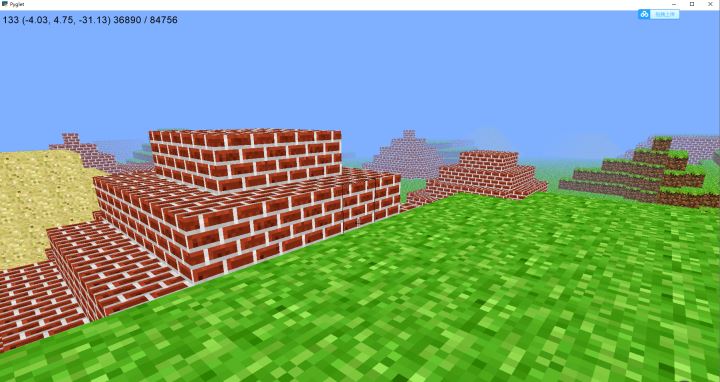
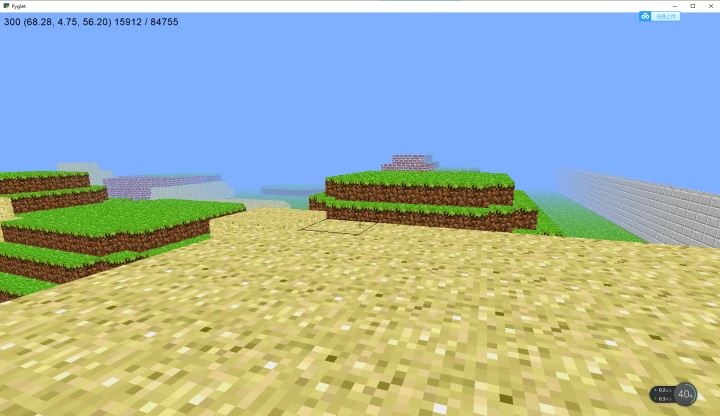
飞行模式下的截图:在天上越飞越远!幸好我手速比较快,不然看不到这截图了!
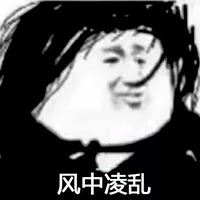
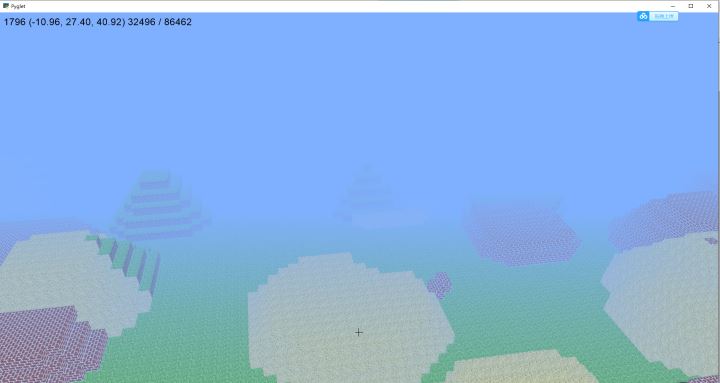
总结
总的来说这初级版本的话很多毛病的哈!哈哈哈哈~大家拿到代码了可以自己修改修改哦~
等一个大佬优化这款Python的我的世界!
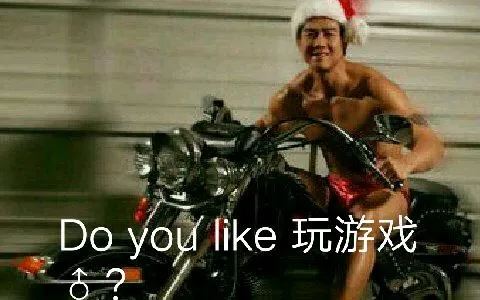
你们的支持是我最大的动力!!mua 欢迎大家阅读往期的文章哦~
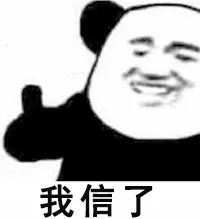
到此这篇关于Python著名游戏实战之方块连接 我的世界的文章就介绍到这了,更多相关Python 我的世界内容请搜索我们以前的文章或继续浏览下面的相关文章希望大家以后多多支持我们!
赞 (0)

